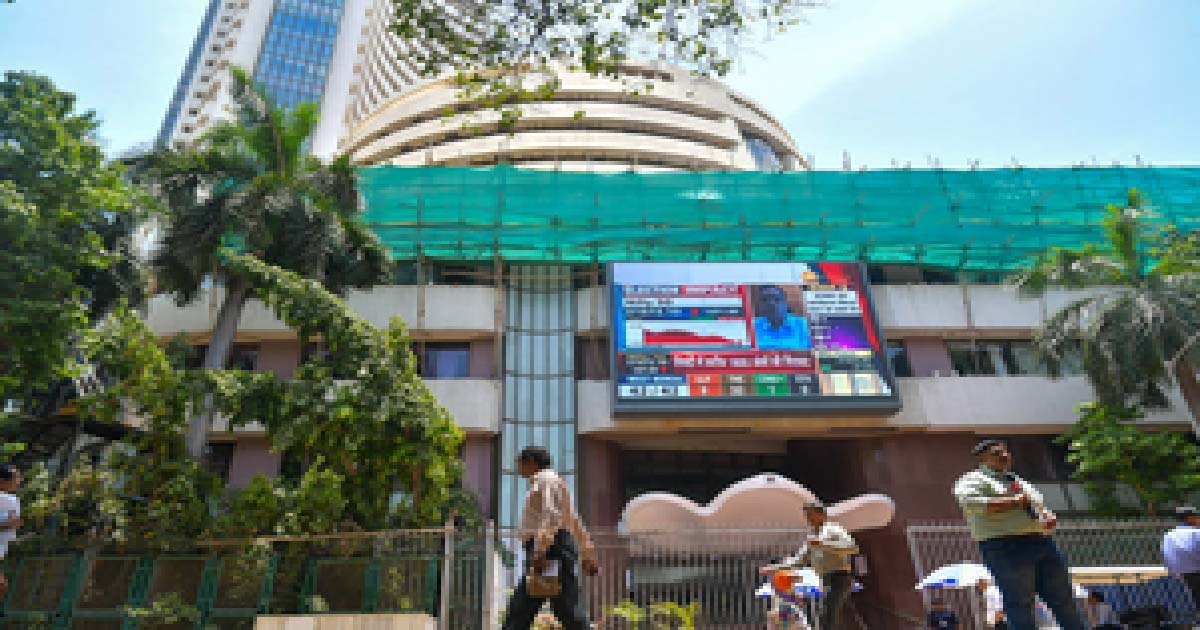Business
Godrej Properties buys 18.6 acre land in Mumbai to develop premium housing project; aims Rs 7,000 cr sales revenue

Godrej Properties Ltd on Friday said it has bought 18.6 acre land at Kandivali in Mumbai to develop a premium housing project and expects sales revenue of about Rs 7,000 crore.
In a regulatory filing, the company informed that the project would have a developable potential of about 3.72 million square feet with an estimated revenue potential of around Rs 7,000 crore.
The project will comprise primarily premium residential apartments with supporting retail spaces.
This will be one of the company’s largest residential developments, and it significantly strengthens the firm’s presence in the western suburbs of Mumbai.
Godrej Properties highlighted that this is the 8th project addition so far this financial year and “takes the cumulative expected booking value from projects added in FY23 to approximately Rs 16,500 crore.”
Godrej Properties, one of the leading real estate developers in the country, had given a full year guidance of adding projects with a booking value potential of Rs 15,000 crore.
To expand its business and create future development pipeline, Godrej Properties acquires land parcels outrightly and also enters into joint development agreements (JDAs) with landowners.
Mohit Malhotra, MD & CEO, Godrej Properties, said the company has added a large and strategically important project in Mumbai.
“This project will allow us to significantly increase our market share in Mumbai over the next several years and fits within our strategy of deepening our presence across key real estate micro markets,” he said.
Malhotra said the company would aim to build an outstanding residential community that creates long-term value for its residents.
The land is strategically placed in a prime locality with excellent access to the Western Express Highway, Metro & Suburban Railway Stations, the company said.
Godrej Properties, a part of business conglomerate Godrej Group, focuses on four key markets — Mumbai Metropolitan Region (MMR), Delhi-NCR, Bengaluru and Pune, although it has a presence in Chennai, Kolkata, Kochi, Ahmedabad, Chandigarh and Nagpur as well.
Godrej Properties has set a target of Rs 10,000 crore sales bookings for 2022-23 as against Rs 7,861 crore registered during the last fiscal year.
It has already clocked a 60 per cent growth in sales bookings during the first half of this fiscal year at Rs 4,929 crore as against Rs 3,072 crore in the year-ago period.
In an interview with PTI last month, Godrej Properties Executive Chairman Pirojsha Godrej had noted that the housing demand continued to be strong despite hike in interest rates on home loans.
He expected a robust sales bookings in the second half of this fiscal.
On financial front, Godrej Properties has reported a 54 per cent increase in consolidated net profit at Rs 54.96 crore in the quarter ended September 2022 on higher income.
Its net profit stood at Rs 35.73 crore in the year-ago period.
Total income also rose to Rs 369.20 crore in the second quarter from Rs 334.22 crore a year ago.
Business
UPI transactions grow 32 pc in Nov as consumption remains robust

New Delhi, Dec 1: The unified payments interface (UPI) saw 32 per cent transaction count growth (year-on-year) at 20.47 billion in the month of November — along with registering 22 per cent annual growth in transaction amount at Rs 26.32 lakh crore, the National Payments Corporation of India (NPCI) data showed on Monday.
Average daily transaction amount in November stood at Rs 87,721 crore, the NPCI data showed.
The month of November recorded 682 million average daily transaction counts, up from 668 million registered in October.
Meanwhile, monthly transactions via instant money transfer (IMPS) stood at 6.15 lakh crore in November, up 10 per cent year-on-year, as transaction count stood at 369 million. Daily transaction amount via IMPS stood at Rs 20,506 crore.
In October, UPI witnessed 25 per cent transaction count growth (year-on-year) at 20.70 billion — along with registering 16 per cent annual growth in transaction amount at Rs 27.28 lakh crore.
Notably, UPI continues to dominate the country’s digital payments landscape, with transactions surging 35 per cent year-on-year (YoY) to reach 106.36 billion in the first half of 2025, data showed.
The total value of these transactions stood at a massive Rs 143.34 lakh crore — highlighting how deeply digital payments have become a part of everyday life in India, according to Worldline’s India Digital Payments Report (1H 2025).
Person-to-merchant (P2M) transactions grew 37 per cent to 67.01 billion, driven by the “Kirana Effect,” where small and micro businesses have become the backbone of India’s digital economy. India’s QR-based payment network also saw tremendous growth, more than doubling to 678 million by June 2025 — a 111 per cent rise from January 2024.
India’s Digital Public Infrastructure (DPI) has played a transformational role in enabling universal access to services, bridging urban–rural gaps and strengthening the country’s position as a global digital powerhouse.
Business
Ashwini Vaishnaw flags off Swarnanagari Express, connecting Jaisalmer to Delhi

Jaipur, Nov 29: Railway Minister Ashwini Vaishnaw and Union Tourism Minister Gajendra Singh Shekhawat jointly flagged off the Swarnanagari Express on Saturday, which will connect Jaisalmer with Delhi.
During the inauguration ceremony, responding to the request of Union Minister Shekhawat and the locals, the Railways Minister announced the renaming of the newly-launched train from Jaisalmer–Shakur Basti–Jaisalmer to Swarnanagari Express.
He announced that the train will begin regular operations on December 1.
The minister said that development work at Jaisalmer railway station is in its final phase and is expected to be completed within a month.
“Efforts will be made to ensure that Prime Minister Narendra Modi inaugurates the upgraded station,” he said.
Union Minister Vaishnaw also confirmed that the railway line between Jaisalmer and Jodhpur will be upgraded soon.
According to officials, these initiatives will significantly improve connectivity, boost tourism, and strengthen strategic infrastructure in the border region.
Ashwini Vaishnaw said that the connectivity will strengthen national security.
Preparations are underway to connect several regions along the Rajasthan–Pakistan border with new railway lines.
He said that extending rail connectivity to these sensitive areas will significantly enhance the country’s security infrastructure.
Under this initiative, new railway lines are proposed for Anupgarh, Bikaner, Jaisalmer, Barmer, and Bhildi.
The minister arrived in Jaisalmer on Saturday to inaugurate a new train service to Delhi.
The minister also visited stalls under the One Station, One Product scheme and made purchases to promote local artisans.
He said that the Detailed Project Report (DPR) for the proposed border-area railway lines is being prepared and will be completed in the coming months.
“A complete effort will be made to connect the entire border region,” he assured.
He added that railway projects worth approximately Rs 55,000 crore are currently in progress across Rajasthan, including the redevelopment of 85 railway stations.
Work is also advancing on multiple new railway corridors and infrastructure projects.
The new initiatives, officials said, will improve connectivity, boost tourism, and strengthen strategic infrastructure in the border region.
Business
Nifty, Sensex rally for 2nd week over strong Q2 earnings, domestic inflows

Mumbai, Nov 29: The Indian equity benchmarks made marginal gains for the third consecutive week, supported by positive global cues, robust domestic inflows and strong Q2 earnings.
Benchmark indices Nifty and Sensex edged higher 0.34 and 0.52 per cent this week to close at 26,202 and 85,706, respectively.
Analysts said that global cues remained supportive, aided by softer US yields, renewed expectations of a Fed rate cut, and benign crude prices that helped temper inflation concerns.
Broader indices underperformed, with the Nifty Midcap100 and Smallcap100 ending the week down 0.11 per cent and 0.10 per cent respectively.
Gains during the week were led by pharma, PSU banks, media, and IT, while realty, consumer durables, and oil & gas lagged behind.
Indian equities navigated a highly eventful week characterised by alternating phases of volatility, resilience and profit booking, finally closing the week on a positive note.
Nifty reached an intra-day low of 25,842 before bouncing back and making a high of 26,310 on the last day of trading week.
Bharat K Gala, President, Technical Head, Ventura, said that key corrective zones traders should watch out for is the support zone at 25,851–25,566. A breach of this level can take the index to 25,337 and further to 25,107–24,780 zone.
Domestically, the stronger-than-expected Q2 GDP print, driven by resilient manufacturing, solid construction activity, and healthy private consumption, is set to support sentiment in the near term, market watchers said.
With robust GDP momentum and improving credit growth providing a solid backdrop for earnings acceleration in H2, the medium-term outlook remains positive, they added.
Investors look for cues next week from a critical lineup of macro data, including India and US PMI releases, US core PCE inflation and the RBI’s policy decision.
-

 Crime3 years ago
Crime3 years agoClass 10 student jumps to death in Jaipur
-

 Maharashtra1 year ago
Maharashtra1 year agoMumbai Local Train Update: Central Railway’s New Timetable Comes Into Effect; Check Full List Of Revised Timings & Stations
-

 Maharashtra1 year ago
Maharashtra1 year agoMumbai To Go Toll-Free Tonight! Maharashtra Govt Announces Complete Toll Waiver For Light Motor Vehicles At All 5 Entry Points Of City
-

 Maharashtra1 year ago
Maharashtra1 year agoFalse photo of Imtiaz Jaleel’s rally, exposing the fooling conspiracy
-

 National News1 year ago
National News1 year agoMinistry of Railways rolls out Special Drive 4.0 with focus on digitisation, cleanliness, inclusiveness and grievance redressal
-

 Maharashtra1 year ago
Maharashtra1 year agoMaharashtra Elections 2024: Mumbai Metro & BEST Services Extended Till Midnight On Voting Day
-

 National News1 year ago
National News1 year agoJ&K: 4 Jawans Killed, 28 Injured After Bus Carrying BSF Personnel For Poll Duty Falls Into Gorge In Budgam; Terrifying Visuals Surface
-

 Crime1 year ago
Crime1 year agoBaba Siddique Murder: Mumbai Police Unable To Get Lawrence Bishnoi Custody Due To Home Ministry Order, Says Report












